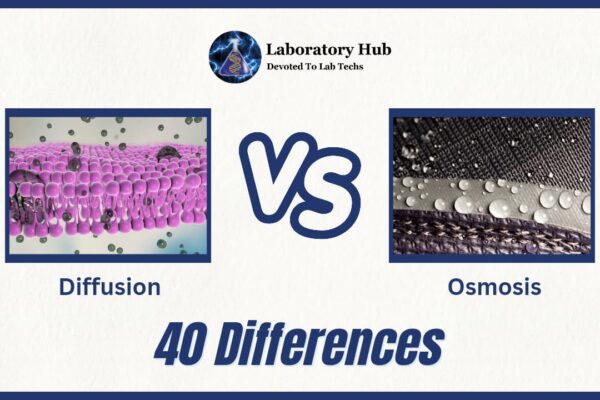Primary vs Secondary Metabolites – 17 Differences
Living creatures create an amazing variety of chemical substances throughout biology. These molecules enable organisms adapt and interact with others. Primary and secondary metabolites distinguish these chemical substances. Discovering the complicated web of life and nature’s chemical variety requires understanding primary and secondary metabolites.
Primary metabolites are necessary for cell growth, development, and reproduction. Carbohydrates, proteins, and lipids are energy-storing metabolites. Primary metabolites also support cellular respiration, photosynthesis, and other metabolic processes. They form intricate biological structures in all species.
Secondary metabolites, on the other hand, perform more specific metabolic tasks. Secondary metabolites, unlike primary metabolites, are not needed for survival but can aid ecological interactions and defensive systems. Alkaloids, terpenes, flavonoids, and phenolic chemicals are among these varied substances. Secondary metabolites attract pollinators, repel herbivores and diseases, and communicate between species.
Biosynthesis and function distinguish main and secondary metabolites. Primary metabolic pathways generate primary metabolites across species. Enzymes and genetic control ensure these pathways’ life-sustaining activities. Secondary metabolites are created by unique metabolic pathways that differ between species. Nutrient availability, predation, and stress modulate these pathways.
Primary and secondary metabolites are important beyond biological activities. Agriculture, food, and pharmaceutical sectors use primary metabolites. Proteins and lipids make cell membranes and store energy, whereas carbohydrates supply energy and structure. Secondary metabolites’ medicinal potential has drawn interest. Drug research and development use secondary metabolites with antibacterial, anticancer, and antioxidant properties.
Thus, primary and secondary metabolites reveal biological chemistry’s complexity. Secondary metabolites provide diversity and specialization whereas main metabolites are fundamental for life. Understanding primary and secondary metabolite production and activities is essential for understanding organism complexity and utilizing nature’s chemical variety. These metabolites may help create new medications, improve agriculture, and better understand nature.
S. No. | Aspect | Primary Metabolites | Secondary Metabolites |
1 | Definition | Essential compounds required for normal growth, development, and reproduction | Non-essential compounds produced during specific stages or conditions |
2 | Occurrence | Found in all living organisms | Found in specific organisms or under certain conditions |
3 | Biosynthesis | Produced through common metabolic pathways | Produced through specialized metabolic pathways |
4 | Function | Involved in basic cellular functions and essential metabolic processes | Contribute to ecological interactions, defense mechanisms, and adaptation |
5 | Quantity | Present in large amounts | Present in relatively smaller amounts |
6 | Biological Role | Critical for growth, development, and survival | Often play specific roles in defense, signaling, or attraction |
7 | Examples | Sugars, amino acids, nucleotides, fatty acids | Alkaloids, terpenoids, flavonoids, antibiotics |
8 | Regulation | Regulated by feedback mechanisms and metabolic pathways | Often regulated by environmental cues and stress conditions |
9 | Evolutionary Conservation | Generally conserved across species | Often vary among species and can be species-specific |
10 | Enzymes | Commonly involve enzymes of central metabolism | Often require specific enzymes for biosynthesis |
11 | Synthesis | Synthesized during active growth and development | Synthesized in response to specific stimuli or stress conditions |
12 | Structural Diversity | Limited structural diversity | High structural diversity, often with complex chemical structures |
13 | Storage | Not commonly stored for long periods | Can be stored in specialized structures for later use |
14 | Intermediates | Often serve as intermediates in primary metabolic pathways | Rarely serve as intermediates in primary metabolic pathways |
15 | Energy Yield | Can be utilized as energy sources for cellular processes | Do not serve as primary energy sources |
16 | Role in Human Health | Essential for normal human physiological functions | Can have medicinal properties or toxic effects on human health |
17 | Role in Industry | Often used as raw materials in industrial processes | Can have industrial applications in pharmaceuticals, agriculture, and cosmetics |
Also read: Primary vs Secondary Immune Response- 15 Differences
Frequently Asked Questions (FAQS)
Living organisms need primary metabolites for fundamental metabolic activities. Energy generation, cell structure, and biochemical processes require carbohydrates, proteins, lipids, and nucleic acids. All organisms need these compounds for growth, development, and reproduction.
Secondary metabolites provide specific metabolic tasks. Alkaloids, terpenes, flavonoids, and phenolics are among them. Secondary metabolites help defend, communicate, and attract pollinators. They benefit ecological relationships but are not necessary.
Primary metabolites are crucial to life. They generate complex biological structures using conserved metabolic pathways. Secondary metabolites are created through specialized biochemical pathways and are not needed for survival. Their ecological roles and biological activity vary.
Primary metabolic pathways generate primary metabolites across species. These routes include critical enzymes and genetic control. Glycolysis and the citric acid cycle create carbs, whereas transcription and translation synthesize proteins.
Secondary metabolites are typically created by organisms’ unique metabolic pathways. Nutrient availability, predation, and stress modulate these pathways. Enzymes and genetic regulation produce various chemical molecules during secondary metabolite biosynthesis.
Environmental interactions depend on secondary metabolites. Some secondary metabolites defend against herbivores and diseases. Others encourage pollinators or signal between species. These molecules help organisms adapt, survive, and interact.
Primary metabolites have several industrial uses. Biofuels, food, and drinks are made from carbohydrates. Biotechnology, medicines, and food employ proteins. Cosmetics, detergents, and drugs use lipids.
Secondary metabolites may be therapeutic. Drug research and development benefit from their antibacterial, anticancer, and antioxidant properties. Cosmetics, fragrances, and flavors employ secondary metabolites.
Secondary metabolite research uses natural product isolation, chemical synthesis, and genetic engineering. Researchers characterize these chemicals to understand their biological activity and uses. Technology and biotechnology have made novel secondary metabolites possible.
Primary and secondary metabolites improve organisms’ adaptation and survival, increasing biodiversity. Secondary metabolites help organisms interact with their environment, protect against predators and diseases, and communicate with other species. The diversity of primary and secondary metabolites enriches nature.







